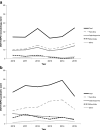Trends in paediatric inpatient antibiotic therapy in a secondary care setting
- PMID: 29948254
- PMCID: PMC6061058
- DOI: 10.1007/s00431-018-3185-z
Trends in paediatric inpatient antibiotic therapy in a secondary care setting
Abstract
There is growing attention for antimicrobial stewardship in paediatrics. Currently, little is known about secondary care antibiotic practice. We analysed trends in time with respect to inpatient antibiotic use in a secondary paediatric care setting. Total inpatient antibiotic consumption per year (2010-2015) and antibiotic prescriptions for urinary tract infection (UTI) and lower respiratory tract infection (LRTI) were analysed. Variables were total, antibiotic-specific, and intravenous days of therapy (DOT/100PD) and for UTI/LRTI treatment type, route and duration. Third-generation cephalosporin use decreased (DOT/100PD 11.6 in 2011 vs. 5.1 in 2015; p < 0.001); intravenous antibiotics were prescribed less often (p = 0.06). These findings were confirmed for the specific diseases: third-generation cephalosporin use decreased for both UTI (93% vs. 45%; p = 0.002) and LRTI (14% vs. 6%; p = 0.18); the duration of intravenous therapy decreased (UTI p = 0.02; LRTI p < 0.001). Median LRTI treatment duration was 9.2 days in 2008 and 6.6 in 2015 (p < 0.001); penicillin prescriptions were more narrow in spectrum (p = 0.02).
Conclusion: A decrease in third-generation cephalosporin use and intravenous route was identified. LRTI treatment was significantly shorter and more narrow in spectrum. This could be explained by awareness and interventions in the context of antimicrobial stewardship. A decrease in antibiotic use is also feasible and important in non-tertiary paediatric wards. What is Known: • Antimicrobial stewardship programmes are effective in reduction of total and broad-spectrum antibiotic use in tertiary paediatric hospitals • The majority of hospitalised paediatric patients are admitted at general, secondary care wards, often for infectious diseases What is New: • Antimicrobial stewardship interventions in secondary care are also effective in establishing a reduction in broad-spectrum antibiotic use, intravenous route and days on antibiotic therapy.
Keywords: Antibiotic stewardship; Antimicrobial therapy; Secondary care hospital; Third-generation cephalosporins.
Conflict of interest statement
Conflict of interest
The authors declare that they have no conflicts of interest.
Figures



Similar articles
-
Comparing appropriateness of antibiotics for nursing home residents by setting of prescription initiation: a cross-sectional analysis.Antimicrob Resist Infect Control. 2018 Jun 14;7:74. doi: 10.1186/s13756-018-0364-7. eCollection 2018. Antimicrob Resist Infect Control. 2018. PMID: 29946449 Free PMC article.
-
Compliance with the current recommendations for prescribing antibiotics for paediatric community-acquired pneumonia is improving: data from a prospective study in a French network.BMC Pediatr. 2016 Aug 12;16(1):126. doi: 10.1186/s12887-016-0661-3. BMC Pediatr. 2016. PMID: 27520057 Free PMC article.
-
Understanding the gender gap in antibiotic prescribing: a cross-sectional analysis of English primary care.BMJ Open. 2018 Feb 22;8(2):e020203. doi: 10.1136/bmjopen-2017-020203. BMJ Open. 2018. PMID: 29472269 Free PMC article.
-
Balancing the risks to individual and society: a systematic review and synthesis of qualitative research on antibiotic prescribing behaviour in hospitals.J Hosp Infect. 2019 Apr;101(4):428-439. doi: 10.1016/j.jhin.2018.08.007. Epub 2018 Aug 9. J Hosp Infect. 2019. PMID: 30099092
-
Antibiotic stewardship programmes had a low impact on prescribing for acute respiratory tract infections in children.Acta Paediatr. 2022 Aug;111(8):1500-1506. doi: 10.1111/apa.16381. Epub 2022 May 8. Acta Paediatr. 2022. PMID: 35491435 Free PMC article. Review.
Cited by
-
Retrospective audit of antibiotic use in a university general pediatrics department using hospital pharmacy dispensing data.GMS Infect Dis. 2021 Dec 1;9:Doc06. doi: 10.3205/id000075. eCollection 2021. GMS Infect Dis. 2021. PMID: 34956817 Free PMC article.
-
Use of multiple metrics to assess antibiotic use in Italian children's hospitals.Sci Rep. 2021 Feb 11;11(1):3543. doi: 10.1038/s41598-021-83026-1. Sci Rep. 2021. PMID: 33574450 Free PMC article.
-
Antimicrobial use among paediatric inpatients in a Nigerian tertiary hospital: A three-year point prevalence survey.J Infect Prev. 2023 Mar;24(2):71-76. doi: 10.1177/17571774231152719. Epub 2023 Jan 13. J Infect Prev. 2023. PMID: 36815059 Free PMC article.
-
The predictive utility of prior positive urine culture in children with recurrent urinary tract infections.Eur J Pediatr. 2020 Mar;179(3):415-421. doi: 10.1007/s00431-019-03522-5. Epub 2019 Nov 26. Eur J Pediatr. 2020. PMID: 31768637
-
Antimicrobial stewardship programs; a two-part narrative review of step-wise design and issues of controversy Part I: step-wise design of an antimicrobial stewardship program.Ther Adv Infect Dis. 2020 Jun 19;7:2049936120933187. doi: 10.1177/2049936120933187. eCollection 2020 Jan-Dec. Ther Adv Infect Dis. 2020. PMID: 32612826 Free PMC article. Review.
References
-
- Antimicrobial stewardship definition (2017). http://www.idsociety.org/Stewardship_Policy/. Retrieved 15 Dec 2017.
-
- Davey P, Brown E, Charani E, Fenelon L, Gould IM, Holmes A, et al. Interventions to improve antibiotic prescribing practices for hospital inpatients. Cochrane Database Syst Rev. 2013;4:CD003543. - PubMed
-
- Dellit TH, Owens RC, McGowan JE, Jr, Gerding DN, Weinstein RA, Burke JP, et al. Infectious Diseases Society of America and the Society for Healthcare Epidemiology of America guidelines for developing an institutional program to enhance antimicrobial stewardship. Clin Infect Dis. 2007;44:159–177. doi: 10.1086/510393. - DOI - PubMed
MeSH terms
Substances
LinkOut - more resources
Full Text Sources
Other Literature Sources
Medical

